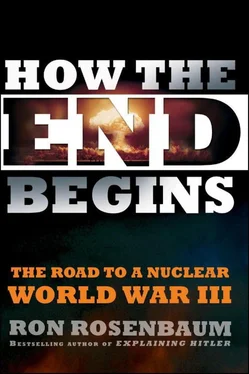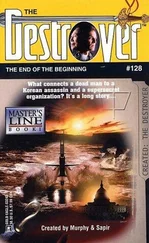This is how it happened. After studying and critiquing the flaws in the U.S. system as an investigator for the Congressional Office of Technology Assessment, where he’d been given above-top-secret security clearance to the apparatus of the sacred SIOP, and writing highly technical books on the subject, he had gone over to consult with Russian specialists in command and control and had discussed ways in which both nations could design systems better equipped to prevent accidental or inadvertent nuclear war. [157]In the short-lived era of good feelings that followed the collapse of communism, when the two nuclear superpowers were feeling their way toward working together to reduce the possibility of an accidental nuclear exchange, he had even received funding from non-governmental services to keep Russian “nuclear design studios” working on safer launch control systems seeking a more rational mutual relationship between the nuclear superpowers. I later confirmed his account of his Moscow work with Blair’s Russian co-designer, Valery Yarynich.
“I had a design bureau [in Moscow] virtually working for me in the 1990s,” Blair told me. “It was because they were broke.” [158]
Blair described a strange interregnum when there was considerable interchange between American and Russian nuclear designers, almost all of whom were looking forward to a future of mutual cooperation and reassurance so that we could slowly climb down together from the twin peaks of nuclear hostility.
“It was a design bureau responsible for missile attack, early warning, using ground radars. They weren’t being paid, they were broke. I was taking money over to them.”
“To whom?” I said, the implications only dawning on me.
“To the Russians—in belts, when I was at Brookings—and I kept this design bureau afloat. It was hundreds of people for months—for six months. They were using their computers and calculating all sorts of things, and I made a lot of great friends. The chief scientists of this design bureau and I were really close.”
But this window of goodwill quickly closed. The Russians went from being a superpower to a Third World economy with a superpower’s nuclear arsenal. When the Russians discovered oil and gas and felt powerful again, they unleashed their resentment at what they felt was their post–Cold War humiliation by resurrecting their nuclear ambitions. Blair had felt a disturbing change in the atmosphere in Moscow in the last few years. He told me his Russian colleague in command and control theory, Valery Yarynich, was scheduled to come over to the U.S. in 2008 under the auspices of Blair’s think tank to discuss further efforts at preventing accidental nuclear war, but that he’d been having “visa problems.” I told Blair I’d go to Moscow if necessary.
But Blair said there was “an atmosphere of fear” over there, one he had not seen since the end of the Cold War. If I wanted a chance to talk freely to Yarynich, I should wait for him to come here because “nobody talks in Moscow anymore. Everyone’s completely puckered about these things now, they really are.”
Puckered?
“Military slang for fear,” he said. “It’s a completely different world,” Blair said. “People are going to jail.” He’s referring to the many politicized purges of Putin enemies on trumped-up charges, the domination of the Russian government by former KGB comrades of Putin, who often use KGB methods of enforcing his authority, the murder of journalists such as Anna Politkovskaya, whose book Putin’s Russia [159]exposed the regime’s Soviet style of jailing those who were threats to state security. [160]Then the blatant poisoning of a dissident using a lethal dose of radioactive polonium in his tea at a London meeting. That sort of thing, which had gone on somewhat in the shadows, was now the virtual daily subject for anyone following the news out of Russia.
THROUGH THE LOOKING GLASS
Blair has changed radically since he held the keys. Back then in the early 1970s his desire was not to abolish nuclear weapons—like the other crewmen I spoke to, he was ready to twist his key under the appropriate authorized circumstances. He started at the top. His initial assignment in the Air Force was supervising the missions, the frequent drills engaged in by the Looking Glass plane, the 747 crammed with electronics, radar, and communications gear that was designed to pick up the president (or his successor) at the onset of an attack and loft him above the mushroom clouds during a nuclear war so he could decide what to target with what was left of our nuclear arsenal or when to engage in “war termination” talks with the enemy. I’d been given a tour of the Looking Glass plane on my deluxe tour of nuclear installations in 1977—yes, the duty officer escorting me said the name “Looking glass” came from Lewis Carroll.
The Looking Glass plane operated out of Offutt Air Force Base in Omaha, the site of our nuclear war command post. After serving there, Blair transferred to a missile base in Montana where he became a wing commander in charge not only of his own crew’s ten Minuteman missiles but also of twenty other crews. He thus had some two hundred missiles under his command, enough to kill a hundred million people depending on what part the missiles would play in the targeting strategy. Down there in the deeply buried, hardened command module of the Minuteman missile silo fields, Blair began to develop some concerns. Some troubling flaws in the nuclear warning, command and control system surfaced that led him to think about the danger of accidental nuclear war, or the chance that a deliberate madman could get around the safeguards.
After Blair left the Air Force and got a doctorate in organization science, he began writing a book on nuclear command and control that was published by the Brookings Institution. It was called Strategic Command and Control: Redefining the Nuclear Threat. The real threat, he argued in that book and in congressional testimony back in 1985 at the height of the Cold War, is not to our ability to attack, but to our ability to launch a retaliatory strike under nuclear attack when, for all we knew, our nodes of communication between the chain of command and the men with the launch keys had been cut off.
Nodes of the command, control and communications system, known as C3, including relay stations that transmitted launch orders from the National Command Authority, officially the president and the secretary of defense, to nuclear submarines running silent miles beneath distant seas, were precariously protected. They were dependent on ground-based relay stations to reach nuclear sub-dedicated satellites or to send VLF and ELF (Very Low Frequency, Extremely Low Frequency) radio signals through the earth, and not invulnerable to being disabled on the ground or in orbit. Both ground stations and satellites are locatable and trackable, unlike the undetectable deep water subs.
Unless we fixed the system, we were vulnerable to having our megatons of weaponry neutralized.
“The main problem with command and control is the threat of decapitation,” he told the Government Operations subcommittee in their 1986 hearings on behalf of the Office of Technology Assessment. “Missiles fired by submarines off the coast can have flight times as short as 5, 6, 7 minutes to Washington and that is simply in my judgment insufficient time really to be able to perform the function necessary to launch forces on warning. One simply cannot assure the survival of the national command authorities or at least the president and his legal successors. Nothing is going to alter that far short of altering our form of government.” [161]
Blair blamed the nuclear strategists who changed the nuclear mission from one focused on deterrence to one focused on war fighting, drawing on concepts like “flexible response” and “controlled escalation.”
Читать дальше











